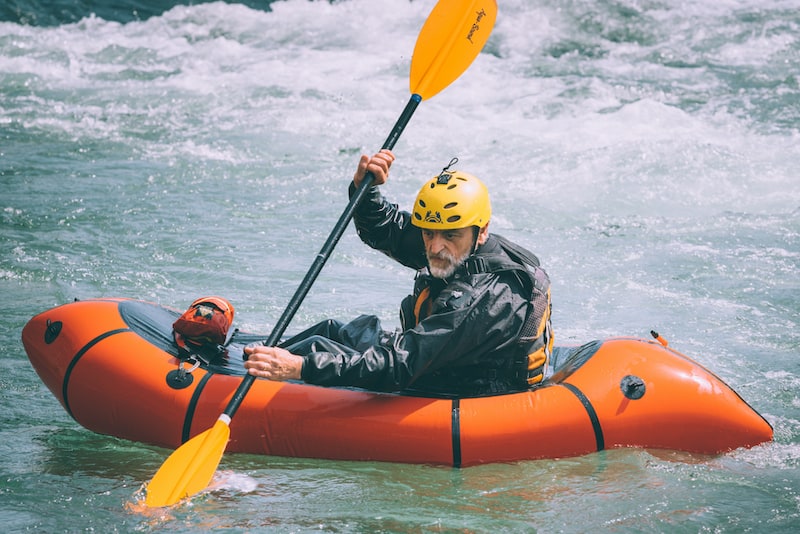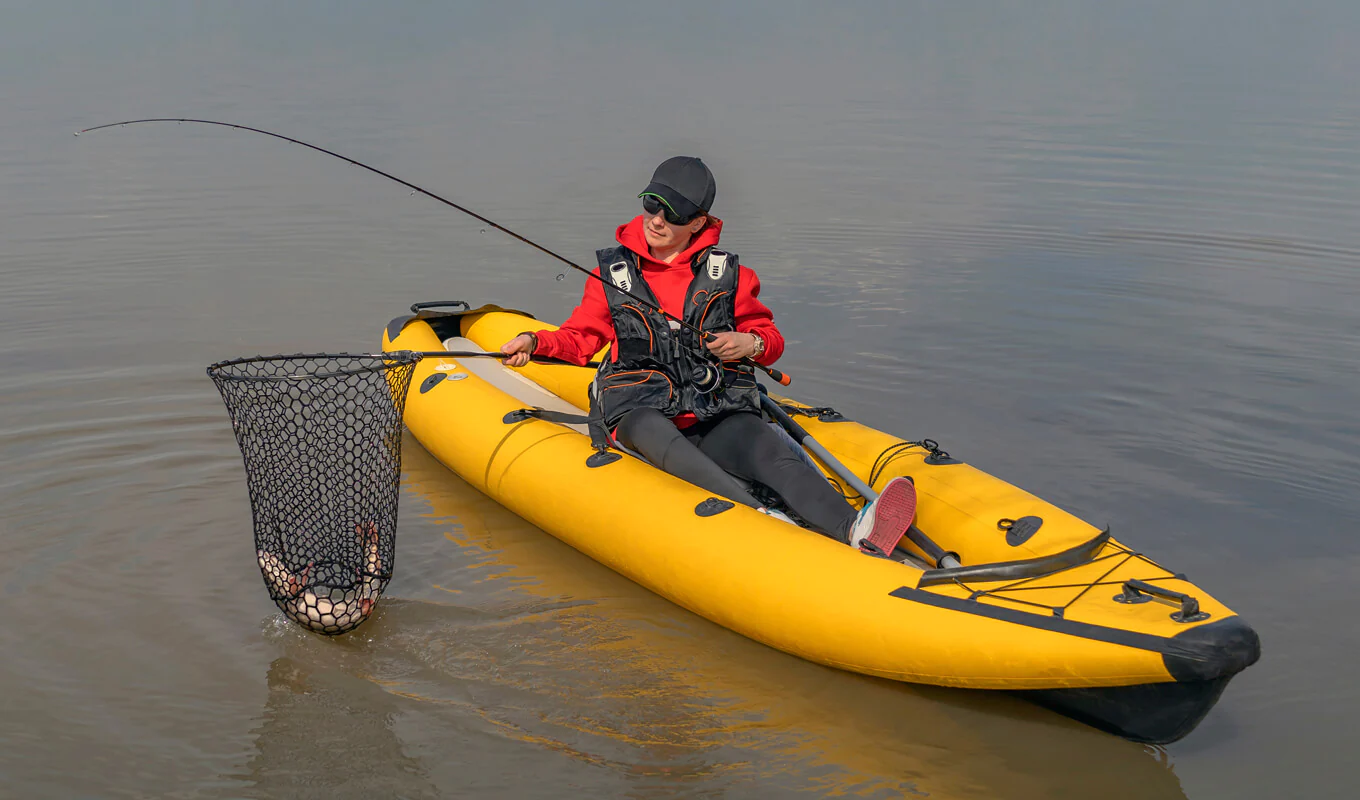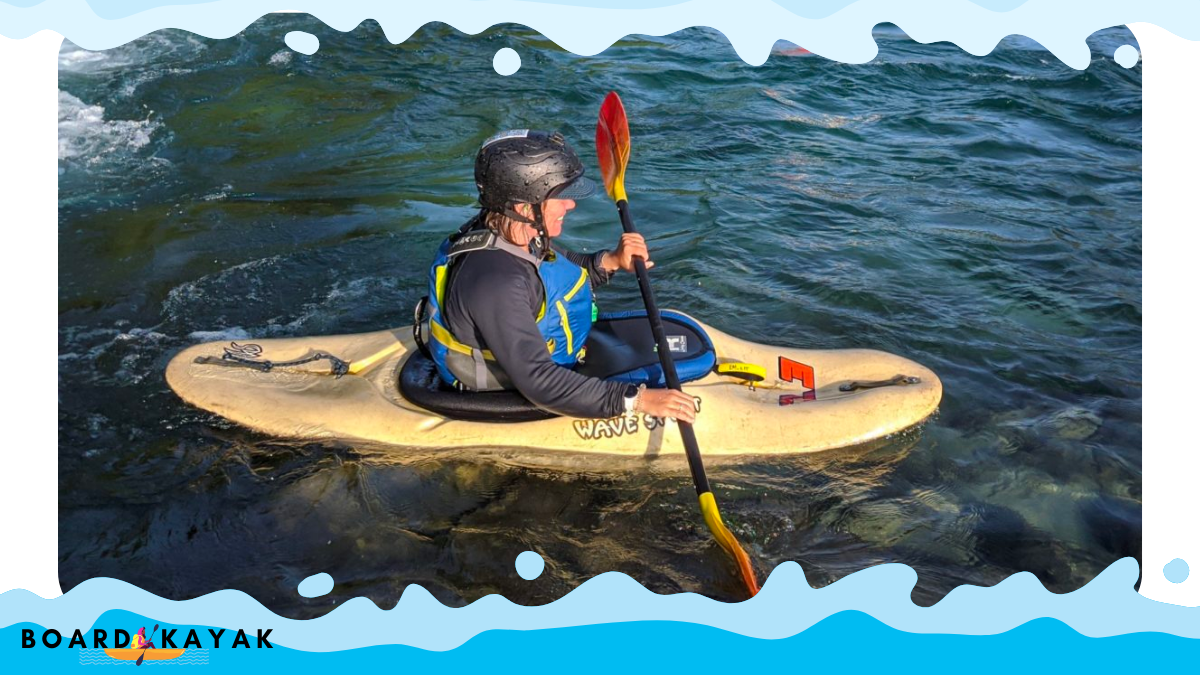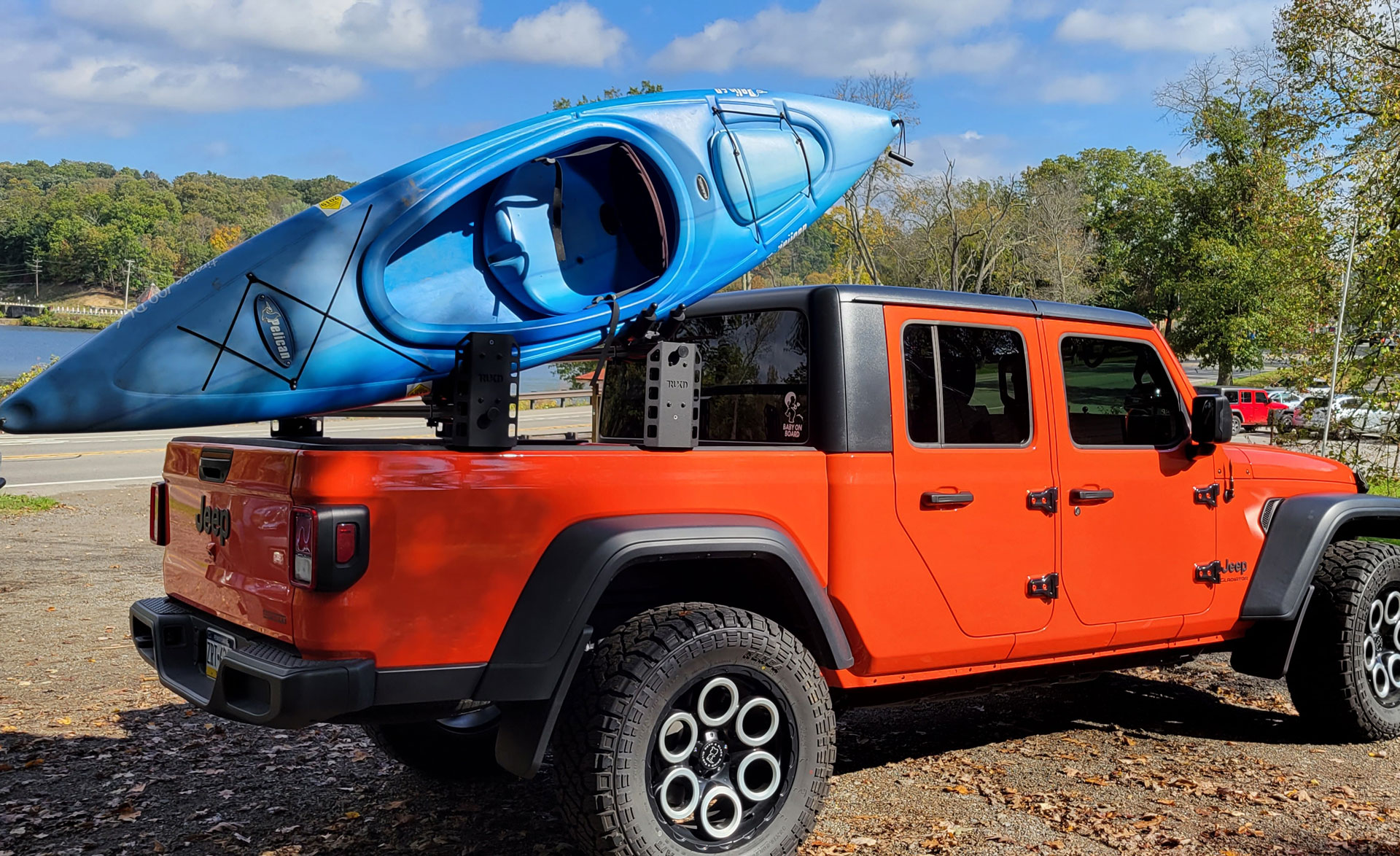
- Alabama
- Alaska
- Arizona
- Arkansas
- California
- Colorado
- Connecticut
- Delaware
- Florida
- Georgia
- Hawaii
- Idaho
- Illinois
- Indiana
- Iowa
- Kansas
- Kentucky
- Louisiana
- Maine
- Maryland
- Massachusetts
- Michigan
- Minnesota
- Mississippi
- Missouri
- Montana
- Nebraska
- Nevada
- New Hampshire
- New Jersey
- New Mexico
- New York
- North Carolina
- North Dakota
- Ohio
- Oklahoma
- Oregon
- Pennsylvania
- Rhode Island
- South Carolina
- South Dakota
- Tennessee
- Texas
- Utah
- Vermont
- Virginia
- Washington
- West Virginia
- Wisconsin
- Wyoming
Discover the Top 8 Lightest, High-Quality Kayaks 2026
Best Lightweight Kayak
Looking for a lightweight kayak? Check out these options:
Pelican Maxim 100X: A 10-foot hard-shell kayak, 36 pounds, 275-pound capacity. Pelican Sentinel 100X: 9.5-foot hard-shell kayak for anglers, 44 pounds, 275-pound capacity. Lifetime Youth Wave: 6-foot kayak for kids, 18 pounds, 130-pound capacity.Lagoon 1 from Advanced Elements : 8.3-foot inflatable kayak, 23 pounds, 250-pound capacity. AirFusion Elite from Advanced Elements: 13-foot hybrid kayak, 32 pounds, 235-pound capacity. Sevylor Quikpak K1: Backpack-to-kayak, 8.6 feet, 18 pounds, 400-pound capacity. Sevylor Quikpak K5: Portable sit-inside kayak, 10 feet, 25.5 pounds, 250-pound capacity. Intex Challenger K1: Affordable inflatable kayak, 9 feet, 27.2 pounds, 220-pound capacity.
Consider materials, size, and use when choosing your lightweight kayak.
Are you searching for the best light-weight kayak for easy transport and solo launch? A light-weight kayak is the perfect solution for hassle-free transportation and effortless paddling. When choosing a kayak, weight is not the only factor to consider. There are other features to consider, such as maneuverability and durability.
You may want to consider an inflatable kayak if you're looking for the lightest weight kayak option. Inflatable kayaks are designed to be lightweight and portable without sacrificing stability and performance. They can be quickly inflated and deflated for easy transport and storage. However, if you prefer a traditional kayak, there are plenty of lightweight options to choose from.
Finding the best light-weight kayak for your needs may be challenging, but this guide will provide you with the essential information you need to make an informed decision. We've compiled a list of the best light-weight kayaks, including the lightest inflatable kayak and the best light-weight kayak for easy transport and efficient paddling. With our guidance, you'll find the perfect light-weight kayak for your next adventure.
The Best Lightweight Kayaks
1. Pelican Maxim 100X
Things we like:
- Construction that is relatively lightweight yet long-lasting
- Adaptable, elegant, and steady in its movements
- Suitable for beginning and intermediate paddlers
- A variety of convenient onboard storage solutions
- A cushy ERGOFORM seat with padding
Things we don't like:
- The bow storage hatch is not watertight and slightly deeper than average.
- Attempting to modify the footrests while the kayak is in motion might be difficult.
To demonstrate that, yes, even hard-shell kayaks have strong competitors in the market for the best lightweight kayaks, I'd like to begin my roundup with one of the most fantastic all-around possibilities Pelican offers. This sit-inside has a RAM-X design that is resistant to impact, and despite its length of ten feet, it weighs just a comfortable thirty-six pounds. In addition to that, it can hold a respectable 275 pounds. Onboard storage is another feature that the Maxim 100X has going for it. This storage space is comprised of a tank well and a hatch. And however, the hatch is neither very spacious nor watertight. Although they contribute to the paddler's comfort, the cushioned seat, foot braces, and molded footrests may be difficult to adjust when the paddler is moving through the water.
Specifications And Data
- RAM-X polyethylene structure of the hard-shell exterior
- 10 feet long by 2.3 feet wide
- Weight 36 pounds
- a maximum load of 275 pounds
I haven't been able to find a lightweight, sit-inside hard-shell that's suitable for beginners that's better than the one I have. The Pelican Maxim 100X is the ideal choice for use in situations involving leisure activities.
2. Pelican Sentinel 100X
Things we like:
- Good maneuverability and stability for casting.
- The cockpit is well-appointed, and there are several onboard storage space choices, including a compartment that can be removed.
- It contains a variety of rod holders in addition to two eyelets for securing accessories.
- Standard motor compatible.
- The hull design provides a lot of stability.
- It is lightweight.
Things we don't like:
- The seat does not have nearly as much padding as other seats.
- A paddle is not included and must be purchased separately.
- When used for fishing, the weight capacity might be somewhat increased.
- Storage space is limited.
This particular Pelican kayak is a 9.5-foot sit-on-top hard-shell model developed expressly with kayak anglers in mind. If you're considering getting one, you might want to give this kayak some severe thought. Pelican's distinctive RAM-X polyethylene, a specially formulated kind of high-density polyethylene, is used in constructing both the Sentinel 100X and the Maxim 100X. However, the Sentinel 100X clocks in at 44 pounds, somewhat heavier than the Maxim 100X. The difference in weight is due to the fully rigged design of the Sentinel 100X, which includes the following:
The cockpit of this fishing kayak is outfitted with a mesh bow storage, various rod holders, accessory eyelets, and an ExoPak detachable storage section that fits in the tank well. This kayak is designed to be used for fishing.
It still has the same capacity of 275 pounds, which, in my view, should have been raised to a more significant number given how much fishing gear anglers need.
When it comes to the question "whatsit on top kayak weighs the least," this one is definitely in the running for the answer.
Don't hold me to that statement, but this fishing kayak may be the lightest one currently available on the market. You get the idea, however; for a kayak designed for fishing, its portability is remarkable.
Specifications And Data
- RAM-X polyethylene structure of the hard-shell exterior (high-density polyethylene)
- It is 9.5 feet long and 2.5 feet wide.
- Weighs 44 pounds
- a maximum load of 275 pounds
Pelican Sentinel 100X is a rigged but lightweight sit-on-top alternative worth considering if you're trying to elevate your kayak fishing experience to the next level. If this describes your goals, read on.
3. Kayak Of The Lifetime Youth Wave
Things we like:
- Kids can quickly re-enter the water after falling off
- The kayak includes paddles
- The kayak has an adjustable footrest to accommodate growing kids
- The kayak has a strong resistance to impact
- Limited manufacturer's warranty of five years
Things we don't like:
- Not suitable for adults or older children
- Low weight capacity of 130 lbs, may not be suitable for heavier children
- Although lightweight, at 18 lbs it may still be cumbersome for some users to transport
- Molded finger handles may not provide a comfortable grip for carrying
- The slope at the end with a swim-up step may not be convenient for all users to re-enter from the water
- Made of High-Density Polyethylene which may lack aesthetic appeal compared to other materials
- Footrest positions may not be suitable for all riders, particularly those with non-standard foot sizes
- 5-year limited manufacturer warranty may provide limited coverage and leave some consumers wanting more security
The Youth Wave from Lifetime weighs only 18 pounds, making it one of the lightest hard-shell kayaks available. It won't fit 95 percent of the people who are reading this, mainly when you take into account that it has a capacity of just 130 pounds, but that's not the point:
This is a sit-on-top that was made with children in mind!
However, despite its ergonomic design, which includes a swim-up deck to facilitate a smooth re-entry and several footrest settings, the cockpit has an unremarkable appearance and is devoid of any additional features. Even the seat itself is not cushioned in any way.
On the other hand, I don't believe there are that many children who would miss it anyhow. The fact that they get to enjoy themselves in this very stable and brilliantly colored kayak should be more than enough for children to have a good time spending the day on the water.
Specifications And Data
- HDPE (High-Density Polyethylene) structure for the hard shell.
- 6 feet long by 2 feet wide
- 18 kilograms in weight
- 130 pounds of carrying capacity
The Youth Wave from Lifetime is a product that comes highly recommended if you are looking for the kayak that is the lightest for your children to use while having fun and learning how to kayak.
4. ADVANCED ELEMENTS Lagoon 1 Kayak
Things we like:
- Comfort is ensured by both the inflatable seat and the foam floor.
- Tracking is improved by the use of the fin as well as the entire bow and stern panels.
- Construction with six separate chambers
- A duffel bag is supplied to make transportation more convenient.
Things we don't like:
- When it comes to tracking wise, it is only ideal for use on calm seas.
- Winds have the potential to impact how stable it is.
- confined space in the cockpit with few onboard storage choices
- It's going to cost you quite a bit.
- It does not include a paddle in the package.
The Advanced Elements Lagoon 1 is not an exception to the rule that inflatable kayaks are recognized for having a lightweight build and being portable. This sit-inside kayak is 8.3 feet in length and weighs just 23 pounds. Therefore, it is susceptible to strong winds and turbulent waves. However, it has a robust and well-made appearance, and the arrangement of its six chambers offers an additional layer of security.
Given that it can hold up to 250 pounds, the fact that the only alternatives for storage space are bungee rigging and a mesh pocket didn't come as much of a surprise to me at all. However, it ought to be sufficient for usage in leisure activities. While I believe it is worthwhile, a paddler who seldom goes out on the water would not be comfortable spending this much on an inflatable kayak.
Specifications And Data
- Inflatable structure made of PVC-coated nylon construction
- 8.3 feet long by 2.8 feet wide
- Weighs 23 pounds
- 250 pounds of carrying capacity
If you want to take your afternoon fun on the water to the next level, the Lagoon 1 is a step up from the standard air-filled kayak, and it is pretty simple to suggest it.
5. ADVANCED ELEMENTS AirFusion Elite Kayak
Things we like:
- The aluminum frame and many air chambers make up the hybrid structure of this product.
- Sleek and lightweight, yet still sturdy and long-lasting.
- It moves and reacts just like a conventional hard shell.
- Because it can be folded up, it is convenient to carry and move about.
- A variety of choices for onboard storage
Things we don't like:
- This kayak is the priciest option available on the list.
- The setup may take more time than a standard inflatable kayak.
The Advanced Elements AirFusion is neither an inflatable nor a hard-shell backpack; instead, it is a hybrid that combines elements of both styles:
A high-pressure air chamber system is integrated into the polyurethane "skin" stretched over the metal frame that makes up the 13-foot shell. The design plays a significant role in how effectively this kayak tricks and maneuvers on the water kayaking one feels similar to paddling a hard-shell boat, albeit the performance gap is much more significant.
Even while the initial setup could take a little bit longer, you are getting the best of both worlds in a kayak that is as light as 32 pounds. If this kayak had a hard shell, it would be the most lightweight option on the market.
Bungee deck lacing, a rear roll-top hatch, and D-ring tie-downs are this vehicle's storage options. Be careful not to exceed the 235-pound weight limit since the item's capacity is just that much.
However, I am not very enthusiastic about the price tag; the AirFusion Elite is my choice for the most expensive product. However, when compared to the cost of comparable folding kayaks, this one is a bargain.
Specifications And Data
- Construction made of a combination of polyurethane and metal
- 13 feet long by 2 feet wide
- 32 kilograms in weight.
- 235 pounds of carrying capacity
Aside from the price tag, the AirFusion is the epitome of everything you should seek in a lightweight kayak. It offers a simple setup, a lightweight design, mobility, and good performance on the water.
6. Sevylor Quikpak K1 1-Person Kayak
Things we like:
- A Quick setup
- It can be carried around with ease, and it weighs less than 20 pounds.
- The bottom, which is made of 21-gauge PVC tarpaulin, is resistant to punctures.
- The backrest makes your riding incredibly pleasant.
Things we don't like:
- The accompanying paddle is not very long-lasting.
Imagine arriving at the shore of the lake with a backpack, and then suddenly, after only five minutes, the rucksack transforms into a full-fledged kayak. I'd like to use this opportunity to introduce you to the Sevylor Quikpak K1:
From a backpack weighing 18 pounds, the whole thing, which consists of a sit-on-top inflatable kayak that is 8.6 feet long, a folding paddle, and a pump, can be transformed into a practical watercraft. In addition, the bag may be used as a seat on its own. In addition, I am a great lover of the design that includes many chambers and a tremendous weight capacity of 400 pounds. Its speed and tracking skills are nothing to write about, yet, it is still a solid enough pick for a kayaking trip that will let you unwind and take it easy.
Specifications And Data
- PVC inflatable structure with a 21-gauge gauge.
- 8.6 feet long by 3 feet wide
- 18 kilograms in weight
- 400 pounds of carrying capacity
If you are looking for a sit-on-top recreational kayak that is as portable and as light as possible, then the Sevylor Quikpak K1 is the kayak for you!
7. Sevylor Quikpak K5 1-Person Kayak
Things we like:
- Construction that is both robust and multi-chambered
- It converts into a pack that is easy to carry due to its lightweight and portable design.
- Approximately 5 minutes are needed to set it up.
- Includes both a paddle and a pump in the package
Things we don't like:
- The three-piece paddle has a little fragile feel about it.
- It floats high and does not cut through the water very well.
- It does not drain well at all.
- For bigger paddlers, this is not the most incredible option.
Another backpack kayaking system, the Sevylor Quikpak K5, is designed for paddlers who are always on the go and want maximum mobility in their craft. The sit-inside inflatable kayak is 10 feet long and weighs 25.5 pounds. It comes with a relatively flimsy three-piece paddle and a pump that are all contained inside a backpack that unfolds into the seat and sprays coverings.
However, passengers will be seated inside the K5 model. If you like the effectiveness and ease of the K1 but have determined that sit-inside kayaks are more to your liking than sit-on-top models, the Quikpak K5 is the model for you.
The 24-gauge PVC structure and the increased cargo space are undeniable upgrades compared to the K1. The capacity has been reduced to 250 pounds. Larger paddlers should probably look elsewhere for their paddling needs.
Specifications And Data
- 24-gauge PVC inflatable construction
- 10 feet long by 2.8 feet wide
- Weighs 25.5 pounds
- 250 pounds of carrying capacity
I'd suggest the Sevylor Quikpak K5 to anybody who wishes to carry a kayak on a trekking trip into the backcountry, particularly if they like a sit-inside model. This is because the K5 is very lightweight and compact.
8. Intex Challenger K1 Kayak
Things we like:
- Exceptional Durability: Made from high-quality vinyl, this kayak is built to withstand the test of time.
- Convenient Inflation: Includes a pump for effortless inflating and deflating, ensuring quick and easy setup.
- Lightweight Aluminum Oars: Crafted from quality aluminum, these folding oars are incredibly lightweight, providing ease of use and maneuverability.
- Designed for Rapids: Developed specifically for use in rapid rivers and paddling under challenging conditions, this kayak offers optimal performance in adventurous environments.
- Portable and Easy to Transport: With its lightweight design, this kayak is perfect for vacationing and allows for hassle-free transportation to your desired water destinations.
Things we don't like:
- Construction using a single layer of skin: This design choice may not offer the same durability and longevity as products with multiple layers of material. Over time, the single layer may be more susceptible to tears or punctures. For a reliable and long-lasting option, consider products that feature reinforced construction or multiple layers.
- Challenging to repack into the carrying bag when sandy or damp: If you plan to use this product in beach or damp outdoor environments, you may encounter difficulties when it comes to repacking it into the carrying bag. This inconvenience can be frustrating, especially when you're trying to quickly pack up and move on. Consider alternative options that offer easier and more convenient packing features, ensuring hassle-free transportation and storage.
Although the Challenger K1 inflatable kayak has a pretty low price tag, I feel obliged to point out that despite its low price, it has a pretty sweet design for an inflatable kayak. Additionally, the sporty-looking plans give it a more confident appearance while also improving its visibility. The sit-on-top kayak measures 9 feet in length and weighs a manageable 27.2 pounds, but it can only support a maximum of 220 pounds. Therefore, larger paddlers may not find it the most suitable option. And even though it comes with a cargo net, I doubt that you'll be able to bring many things aboard because of these restrictions. The Challenger K1 is sold as part of a comprehensive package that also includes a pump, a carry bag, a paddle, and a patch for damage is something that appeals to me.
Specifications And Data
- Construction using vinyl inflatable material
- 9 feet long by 2.5 feet wide
- It weighs 27.2 pounds.
- 220 pounds of carrying capacity
On my list, the Intex Challenger K1, which has an athletic appearance and is a lightweight kayak, is one of the more reasonably priced options. When it comes to value for money, Intext delivers the goods here!
What Makes A Kayak Light?
light weight kayak
When it comes to kayaks, the term "lightweight" can be subjective. Generally, a lightweight kayak is considered to be under 50 pounds. However, weight is not the only factor to consider when choosing a lightweight kayak.
One important consideration is the material used in construction. Hard-shell kayaks are often made of high-density polyethylene, which is durable and resistant to UV light. Inflatable kayaks, on the other hand, are typically made of PVC material, making them more portable and easy to store.
Another factor to consider is the kayak's dimensions. A shorter kayak may be more maneuverable in whitewater, while a longer and narrower kayak may be better for long-distance paddling. However, it's important to also consider if the kayak's dimensions are suitable for your body type, as this may require choosing a slightly heavier model.
When shopping for a lightweight kayak, it's important to keep in mind that weight is not the only factor to consider. Materials used in construction, dimensions, and how it fits your body type are also important considerations. Keep these factors in mind when making your decision to ensure you find the best lightweight kayak for you.
Frequently Asked Questions
What is considered a lightweight kayak?
A lightweight kayak is generally considered to be under 50 pounds. However, this can vary and is subjective.
What materials are commonly used in the construction of lightweight kayaks?
Hard-shell kayaks are often made of high-density polyethylene, while inflatable kayaks are typically made of PVC material.
How do the dimensions of a kayak affect its weight and performance?
Shorter kayaks are typically more maneuverable in whitewater, while longer and narrower kayaks may be better for long-distance paddling. However, it's important to also consider if the kayak's dimensions are suitable for your body type, as this may require choosing a slightly heavier model.
Can inflatable kayaks be considered lightweight?
Yes, inflatable kayaks are often considered lightweight due to their compactness and ease of transport.
How does the weight of a kayak affect my paddling experience?
A lighter kayak requires less effort to carry and allows for more efficient paddling strokes.
Are there any other factors to consider when choosing a lightweight kayak besides weight?
Yes, materials used in construction, dimensions, and how it fits your body type are also important considerations.




![Inflatable Kayaks: Easy to Transport, Fun to Use! [2026]](https://shared-bucket-websites.s3.amazonaws.com/Newly-Designed-Airis-Inflatable-Kayaks-by-Walker-Bay-1650568411745)






